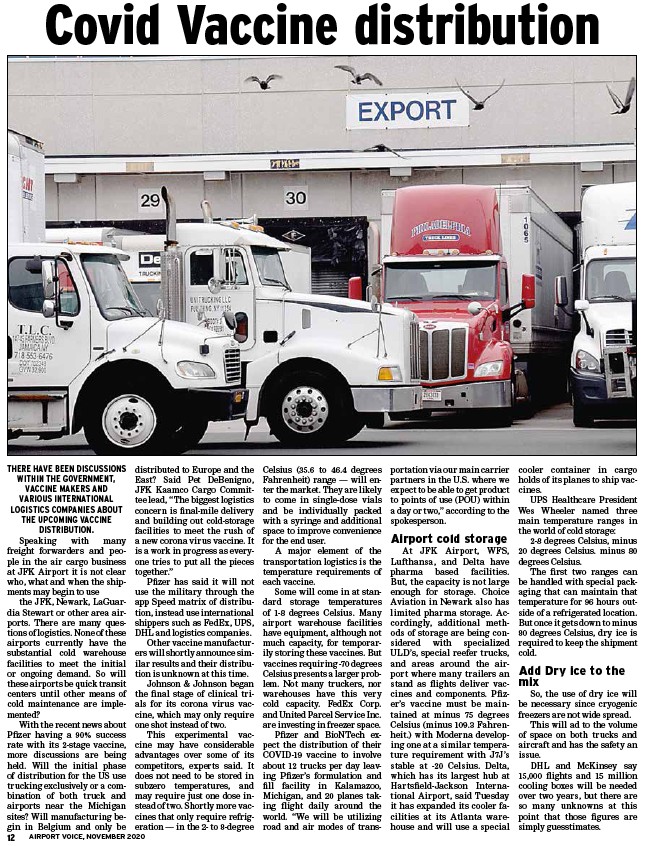
Covid Vaccine distribution
THERE HAVE BEEN DISCUSSIONS
WITHIN THE GOVERNMENT,
VACCINE MAKERS AND
VARIOUS INTERNATIONAL
LOGISTICS COMPANIES ABOUT
THE UPCOMING VACCINE
DISTRIBUTION.
Speaking with many
freight forwarders and people
in the air cargo business
at JFK Airport it is not clear
who, what and when the shipments
may begin to use
the JFK, Newark, LaGuardia
Stewart or other area airports.
There are many questions
of logistics. None of these
airports currently have the
substantial cold warehouse
facilities to meet the initial
or ongoing demand. So will
these airports be quick transit
centers until other means of
cold maintenance are implemented?
With the recent news about
Pfizer having a 90% success
rate with its 2-stage vaccine,
more discussions are being
held. Will the initial phase
of distribution for the US use
trucking exclusively or a combination
of both truck and
airports near the Michigan
sites? Will manufacturing begin
in Belgium and only be
distributed to Europe and the
East? Said Pet DeBenigno,
JFK Kaamco Cargo Committee
AIRPORT V 12 OICE, NOVEMBER 2020
lead, “The biggest logistics
concern is final-mile delivery
and building out cold-storage
facilities to meet the rush of
a new corona virus vaccine. It
is a work in progress as everyone
tries to put all the pieces
together.”
Pfizer has said it will not
use the military through the
app Speed matrix of distribution,
instead use international
shippers such as FedEx, UPS,
DHL and logistics companies.
Other vaccine manufacturers
will shortly announce similar
results and their distribution
is unknown at this time.
Johnson & Johnson began
the final stage of clinical trials
for its corona virus vaccine,
which may only require
one shot instead of two.
This experimental vaccine
may have considerable
advantages over some of its
competitors, experts said. It
does not need to be stored in
subzero temperatures, and
may require just one dose instead
of two. Shortly more vaccines
that only require refrigeration
— in the 2- to 8-degree
Celsius (35.6 to 46.4 degrees
Fahrenheit) range — will enter
the market. They are likely
to come in single-dose vials
and be individually packed
with a syringe and additional
space to improve convenience
for the end user.
A major element of the
transportation logistics is the
temperature requirements of
each vaccine.
Some will come in at standard
storage temperatures
of 1-8 degrees Celsius. Many
airport warehouse facilities
have equipment, although not
much capacity, for temporarily
storing these vaccines. But
vaccines requiring -70 degrees
Celsius presents a larger problem.
Not many truckers, nor
warehouses have this very
cold capacity. FedEx Corp.
and United Parcel Service Inc.
are investing in freezer space.
Pfizer and BioNTech expect
the distribution of their
COVID-19 vaccine to involve
about 12 trucks per day leaving
Pfizer’s formulation and
fill facility in Kalamazoo,
Michigan, and 20 planes taking
flight daily around the
world. “We will be utilizing
road and air modes of transportation
via our main carrier
partners in the U.S. where we
expect to be able to get product
to points of use (POU) within
a day or two,” according to the
spokesperson.
Airport cold storage
At JFK Airport, WFS,
Lufthansa, and Delta have
pharma based facilities.
But, the capacity is not large
enough for storage. Choice
Aviation in Newark also has
limited pharma storage. Accordingly,
additional methods
of storage are being considered
with specialized
ULD’s, special reefer trucks,
and areas around the airport
where many trailers an
stand as flights deliver vaccines
and components. Pfizer’s
vaccine must be maintained
at minus 75 degrees
Celsius (minus 109.3 Fahrenheit.)
with Moderna developing
one at a similar temperature
requirement with J7J’s
stable at -20 Celsius. Delta,
which has its largest hub at
Hartsfield-Jackson International
Airport, said Tuesday
it has expanded its cooler facilities
at its Atlanta warehouse
and will use a special
cooler container in cargo
holds of its planes to ship vaccines.
UPS Healthcare President
Wes Wheeler named three
main temperature ranges in
the world of cold storage:
2-8 degrees Celsius, minus
20 degrees Celsius. minus 80
degrees Celsius.
The first two ranges can
be handled with special packaging
that can maintain that
temperature for 96 hours outside
of a refrigerated location.
But once it gets down to minus
80 degrees Celsius, dry ice is
required to keep the shipment
cold.
Add Dry ice to the
mix
So, the use of dry ice will
be necessary since cryogenic
freezers are not wide spread.
This will ad to the volume
of space on both trucks and
aircraft and has the safety an
issue.
DHL and McKinsey say
15,000 flights and 15 million
cooling boxes will be needed
over two years, but there are
so many unknowns at this
point that those figures are
simply guesstimates.